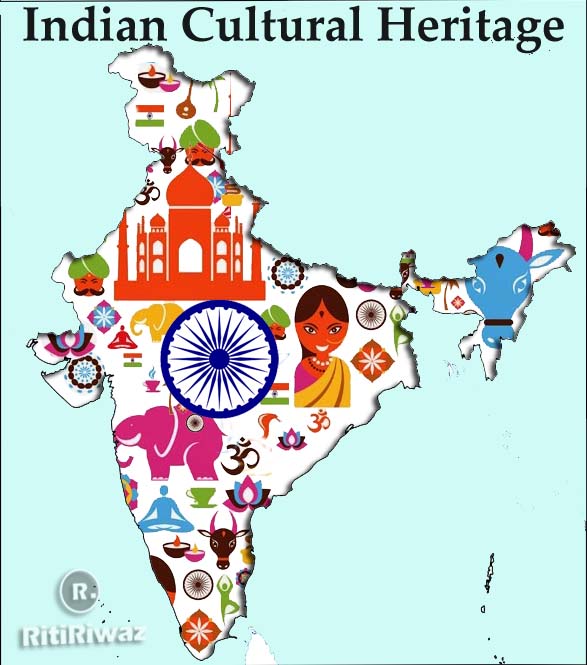Indian Cultural Heritage – Unity Through Diversity

India is a land of rich culture and heritage, where people of different religions and cultures live together in harmony. Its a federal union with different languages, food, dress, belief, and other cultural identities, but they still are together with the same temperament of being an Indian.
People wholeheartedly participate in each other joy and sorrow. A festival celebration is not limited to a family and a home but is celebrated by the whole community or neighborhood together. Indian wedding is also a big occasion when the union of bride and groom is celebrated by two families with various traditions and beliefs. There may be various cultures and religion but as a whole nation, everybody celebrates major events together and wholeheartedly.
Our culture spreads realization of ‘sat’ (truth) ‘chit’ (concentration) and ‘anand’ (pleasure). Indian culture aims at achieving the goal of ‘Dharma’ (righteousness) ‘Artha’ (material possession), ‘Kama’ (physical pleasure) and ‘Moksha’ (salvation).
Indian culture is exposed to the unbroken sequence of civilizations from ancient times till recent past. Even after various foreign invasions, Indian culture is able to survive because of its dynamism and flexibility and it inherits the best of all the external influences.
Starting from Aryans, Kshtrap, Kushan, huns, Persian, turks, Arabs, Mughal, Britishers, French, etc. castes and tribes have come to India which have helped India gain a rich Culture and Heritage.
Indus Valley Civilization was one of the first civilizations on earth. Hindu religion and caste system began in India during the Vedic period. After the decline of the Harappan civilization, a new culture flourished in the same region known as Aryan culture. The Aryans composed the four Vedas- the Rig Veda, the Sama Veda, the Yajur Veda, and the Atharva Veda.
Its a birthplace of Hinduism, Buddhism, Jainism, and Sikhism while people also follow Christianity and Islam. All these religions have grown here quite freely with their different sects and sub-sects. Hinduism which is the religion of the majority has various sects like Saivism, Vaishnavism, Shaktism, Tantricism, Sun-cult, Ganapatya-cult, etc. Buddhism with Mahayana, Hinayana, Vajrayana and Kalachakrayana sects, Jainism with Svetambar and Digambar sects. Islam with Shia, Suni, Shafi, and Hanafi sects, Christians with Catholic and Protestant sects live in this country alongside each other quite peacefully.
The two famous Epics of India The Ramayana and The Mahabharata are the backbone of Indian culture. Ramayana is the story of Lord Ram who went on 14 years of exile with his wife and younger brother and brings the principles and values taught to children by every parent. While Mahabharata throws light upon the politics played in ancient times. It teaches us about our duties assigned to us and tells us about what will happen for our wrongdoing and sins we commit. They teach us how to be good human beings and the importance of relationships in life and the meaning of love.
Bhagavad Gita, is a conversation between Lord Krishna and Arjuna where Krishna explains karma, the self, the Supreme Self, the purpose of yoga. The difference between ourselves and our material body, how our environment affects our consciousness, and how to attain the perfection of life.
Ancient India saw the rise of two very important religions i.e. Jainism and Buddhism. Both the reforms emphasized moral life and founded an order of monks and established monasteries called sthanakas in Jainism and viharas in Buddhism.
During the Medieval Era, the Turks and Mughal introduce fresh ideas in the socio-cultural field. The Mughal emperor Akbar established a religion named Din Ilahi. The Mughal emperors encouraged the blending of cultures to create a united India. Then was the evolution of Sufism, Bhakti Movement and Sikhism in India.
In the Modern Era, English education was introduced which led to India’s contact with the western world. Both Hindus and Muslims live in harmony and participates in each other’s festivals. By the arrival of the 20th century, the social conditions were unfavorable for women, the birth of girl child was not considered good. Child marriage was common and inter-caste marriage was not allowed, there was a social gap between high caste and lower caste. Ram Mohan Roy fought against the social practices and used religious text to prove that these social practices were not good.
Mahatma Gandhi upheld the values and spirit of India’s cultural heritage throughout his life. He always advocated Indian cultural heritage and believed in the oneness of all human beings.
Gandhi wrote, “Our culture is a treasure-house of such great values as are hardly found in other cultures. We have not given its due recognition; we have seen it and learned about it disregarding its proper study and undermining its values. We have almost discarded it by not conducting ourselves according to its tenets; [but] without the conduct, more intellectual knowledge is just like a corpse that may be preserved as the mummy. It seems good to look at, but fails to inspire.”
Since Independence, Indians themselves have become increasingly keen to promote their sense of national identity and cultural unity. In consequence, there has been a revival of interest in indigenous folk arts, especially in the realm of music and dance. We must never forget our rich cultural heritage of our ancient seers, philosophers, and sages and abide by those rules, regulations, and lifestyles.
Suggested Read: Culture and Tradition of Indian States
